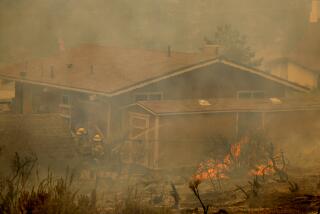Activists Accuse U.S. of Using Fire Prevention Funds to Benefit Loggers
SACRAMENTO — An environmental group charges in a report set for release today that taxpayer money intended to ease the threat of fire in the overgrown forests of the Sierra Nevada is being used instead by the U.S. Forest Service to push commercial logging operations on public lands.
The study by the John Muir Project, a nonprofit conservation group, concludes that fire protection projects on 56,000 acres in the Sierra have tended to involve logging operations that cut trees deep in the forest instead of clearing undergrowth around vulnerable mountain towns.
Chad Hanson, the group’s executive director and author of the report, said the Forest Service “has abused the policy and funding intent” of the National Fire Plan, the omnibus blueprint approved by Congress in 2000 to protect rural communities, wildlife and watersheds from backwoods blazes.
Matt Mathes, a U.S. Forest Service spokesman, denied the allegations and called the 20-page report “a selective interpretation” that fails to recognize that commercial timber cutting in some cases is a tool to help thin the nation’s forests, which have become overgrown after a century of aggressive firefighting in the rural West.
“Unlike the old days, timber production is no longer the driving force for us,” Mathes said. “Protection from fire is now the driving force.”
Timber industry officials, meanwhile, accused the Muir project of twisting the truth in an era when commercial logging in federal forests has been reduced more than 90% from a decade ago.
“It’s too bad that propaganda is getting in the way of sound decision-making based upon sound science,” said Chris Nance, a California Forestry Assn. spokesman. “Science is driving this process, not whether the trees are marketable.”
The timber industry and environmentalists have long fought over whether fire prevention efforts are used to mask attempts to boost commercial logging.
Using Forest Service documents, Hanson determined that 83% of the new projects funded under the National Fire Plan involve commercial logging and none focus near towns to remove flammable undergrowth, which provides a fuel ladder that fire can climb to reach treetops and rage out of control.
The average distance to the nearest town is six or seven miles, the report said. In some cases, it said, outhouses or back-country camps were defined as urban areas to justify cutting trees.
The study said 75% of the projects involve removing trees in excess of 12 inches in diameter, and 94% are in mature or old-growth forest suitable for threatened species such as the California spotted owl or the Pacific fisher, a weasel-like creature. In addition, the study said, many trees slated for removal are not dead but are being eyed because they represent potential sources of commercial lumber.
While the National Fire Plan envisioned reducing flammable undergrowth near homes, the study concluded, “the Forest Service has overwhelmingly spent these funds on big commercial logging projects.”
Mathes of the Forest Service said the process of how best to fix the forest is being driven by “the best current science.”
He said the Muir report fails to account for a key factor--that 14 of 16 projects cited are in the Lassen and Plumas national forests, which are covered by a separate set of rules signed into law in 1998 by President Bill Clinton.
Those rules, though controversial among environmentalists, allow far-flung thinning operations deep in the forest as a way to knock down a fire before it approaches a community.
In addition, Mathes said, Congress allowed U.S. Forest Service officials to use National Fire Plan funding for commercial timber cutting within fuel reduction project sites.
More to Read
Sign up for Essential California
The most important California stories and recommendations in your inbox every morning.
You may occasionally receive promotional content from the Los Angeles Times.









